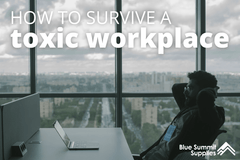Preventing burnout in the workplace is to everyone’s benefit. Employees are more motivated and productive when they aren’t feeling burnt out, and avoiding burnout can prevent larger health issues from developing.
A Gallup study found that 23% of employees felt burned out at work very often and another 44% of employees said they felt burnt out at work sometimes. Burnout has become such a workplace and health crisis that The World Health Organization has defined it and added it to the International Classification of Diseases.
This post will dig into the signs of burnout at work so that you can begin implementing prevention strategies right away. Learn how to deal with burnout at work with actionable strategies for both employees and employers.

Signs of Burnout to Watch Out For
- Ongoing Exhaustion and Fatigue: Burnout takes a toll on the body. Whether from lack of sleep or prolonged stress, exhaustion can be a sign of burnout.
- Sporadic Mood Swings: People who experience burnout are often moody and can switch from one mood to the next quickly. If you notice sudden mood swings or the people around you start to notice them, you may be experiencing burnout.
- Persistent Negative Outlook: Negativity can take its toll on yourself and the people around you. If you have a constant negative outlook on the things that once brought you joy or about life in general, it may be a sign of burnout.
- Feelings of Detachment and Loneliness: People who feel burnt out often experience a sense of detachment from those around them. You may feel like you are on an island all alone and that you don’t need anyone else.
- Apathetic, Uninterested, and Indifferent: A lack of enthusiasm can be a sign of burnout. When we experience burnout, we lose interest in our work, the people around us, and the activities that used to excite us.
- Strained Immune System: Between flu season, COVID, and just a pesky old cold, lowering your immune system’s defenses is probably the last thing you want to do. Yet, as we get burnt out, our immune system suffers, which can lead to more frequent illnesses.
Preventing Burnout in the Workplace: Employees
Only you can listen to your own body. It’s important to watch for changes in your mood, appetite, sleep, and general physical wellbeing. You’re not doing yourself or the people around you any favors by letting burnout take hold. Follow our simple strategies for mitigating and preventing burnout. Even if you don’t feel burnt out right now, continuing these wellness exercises will keep your body and mind sharp, avoiding the chance burnout will ever develop.
Stop Saying Yes to Everything
You don’t have to say yes to everything, and you probably shouldn’t. We are asked to do things, go to things, and participate in things all the time, and it’s up to us to navigate what’s most important. If you say yes to everything, you won’t have any time left over for yourself or your family. Before automatically saying yes, consider if you actually have to do whatever is being asked of you. Do you want to do it? Does it contribute to your goals in some way?
Learning to say no is a skill that you need to practice, and for many people, it doesn’t come naturally. If you’re someone who always says yes, try saying no (politely) next time to guard your own time. After all, you only have so much of it to spare.

Understand Your Circle of Control
Whether you’re feeling burned out at work or at home, understanding your circle of control will help you mentally manage stress and the unknown. 2020 was a year of the unexpected, and it has left many of us feeling like we’re not in control of our own lives.
This is a huge burden on our brain space. We want to feel in control, and we want to know what the future will entail. Take back some control by separating what’s inside and outside of your circle of control.

What’s inside your circle of control:
- How others make you feel
- What you say
- Your decisions
- What you buy
- What you eat
- How much sleep you get
What’s outside your circle of control:
- How other people feel
- What other people say
- The weather
- What’s on the news
There are a great number of things in your life that you can’t do anything about. These are the aspects of your life you need to try hard to move past. Instead, focus more of your energy on the parts of your life that you can control. You may not be able to change the weather, but you can invest in a good pair of boots. You may not be able to control your boss’s aggressive behavior, but you can control how you act around them.
💡 Learn more about the techniques you can implement to combat a lack of control inside and outside of the workplace.
Listen to Your Body
Your body is constantly speaking to you. If you feel more tired than usual, if you develop aches and pains, or start getting frequent headaches, don’t ignore these feelings. When you notice a negative change in your body, it’s time to get to the bottom of it. Feeling bad physically could be as simple as not drinking enough water or getting enough sleep. Or, it could be a sign of burnout developing.
When you’re busy, take the time to check in with your body. Feeling tired or physically strained is your body telling you that you need to change course. It’s a warning sign; ignoring it will only make the problem worse down the road.
The best medicine is prevention. The sooner you catch a physical or mental health concern, the sooner you can implement preventative and mitigating changes in your life.
Practice Mindfulness
Meditation provides a long list of health benefits. It can improve memory, enhance focus, increase happiness, reduce stress, and prevent aging. It strengthens your mind so that you can do your best work. It also prevents burnout by allowing yourself the time to check in physically and mentally.
To someone who hasn’t meditated before, it may sound foreign and daunting. Truthfully, meditation can be quite simple, and it only requires one minute of your time. Box breathing or a one-minute mindfulness exercise can get you started. Work your way up from there by adding longer breathing sessions or mindfulness activities into your day. Make a habit of meditation and track your progress. A little bit every day will make a big difference long-term.
Exercise, Even If You Don’t Want To
Sorry to bring this up, but exercise matters. It’s not just about attaining that beach body you’ve always wanted. Physical activity releases endorphins, a chemical that relieves stress and pain, into our bodies. Despite the strain and sweat in the middle of exercising, you’ll feel good once it’s all over. Exercising can improve your mood, make you sleep better, and, in moderation, it will reduce your risk of burnout.
Spend Time Outside
Spending time in nature is such a simple strategy that can yield a number of incredible health benefits. Spending time outside can reduce stress, combat depression, eliminate fatigue, improve focus, and more. And it’s free!
Spend time in your yard, take a walk through your neighborhood, or walk to a local park. Even if you live in a city, there are plenty of green spaces to discover. Take a look at a Google map surrounding your home and your place of work. What parks or small pockets of nature are within walking distance?
If timing is an issue, combine spending time in nature with other tasks that are already on your to-do list. Exercise outside, take your dog for a walk, spend time with your kids in a park, eat your lunch outdoors, or set a walking meeting to create more reasons to get outside.
Preventing Burnout in the Workplace: Employers
Dealing with burnout at work is to everyone’s benefit. Employers should invest both time and resources into ensuring no employee reaches a place of burnout. In the long run, this will help productivity and prevent more serious illnesses or health concerns.
Watch for Signs of Burnout Fatigue
Your employees may not be able to spot their own burnout. It’s up to you as the employer to ensure your team is happy and healthy. Watch for signs of burnout, including reduced motivation, productivity, and enthusiasm. Burnout may also manifest as chronic fatigue, mood swings, or apathetic behavior.
Ensure that you or someone from your HR department is checking in with employees every so often to understand their workload and wellbeing in the office. Catching burnout early will prevent office conflict, keep productivity steady, and will reduce sick day requests in the long-term.
Provide and Encourage Frequent Breaks
Employees need to know that it’s okay to take breaks. Frequent breaks prevent stress, and they help employees maintain focus.
You should encourage frequent breaks and provide educational information on the best ways to take them. Allow your employees to go for a short walk, establish a quiet space for meditation, or provide healthy snacks. Breaks need to be about rest and rejuvenation, which won’t be accomplished by turning to a news site or scrolling on social media.
Offer Flexibility
Flexibility is incredibly important to employees. It provides the freedom to work in the ways that best suit each individual employee. Offering flexible hours and work from home options will help your team balance their work and personal lives.
Some people work better first thing in the morning, while others prefer to work at night. Some people enjoy the thrill of a bustling office space, while others work better in solitude. Understanding that each member of your team has different needs and working styles will prevent work-related burnout and improve productivity and wellness. Trust your team to complete their work in the ways that best suit them. They’ll be happier and more motivated, and they won’t be eager to leave your place of employment for other less-flexible workplaces.
Provide Learning and Development Opportunities
Learning stimulates the mind and provides employees with a greater sense of purpose in their job. Provide both personal and professional development for your team and ensure time is set aside for these activities. You don’t want these activities to become an extra burden on top of their already intense workload.
Team building activities will strengthen your team's trust and give everyone something to think about that isn’t work. These opportunities can be anything from crafting to learning about office personalities. Consult your team to find out what type of learning opportunities they are interested in.
More from Blue Summit Supplies
💡 The Benefits of Work-Life Balance and How to Maintain it
💡 The Benefits of Office Plants and How to Take Care of Them
We’re always looking for new ways to improve workplace wellness. Follow our office blog for the latest trends, team building activities, office strategies, and more.
If you have any questions or want to talk to someone about office supplies, send us an email or connect with us on Twitter, Facebook, or Instagram.
 For more informative articles about office supplies, subscribe to our email newsletter!
For more informative articles about office supplies, subscribe to our email newsletter!
Never fear, you won't begin receiving daily sales emails that belong in a spam folder. Instead, we promise a fun weekly roundup of our latest blog posts and great finds from across the web. And if you lose interest, it's always easy to unsubscribe with a single click.









